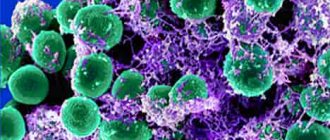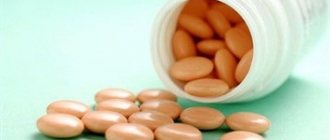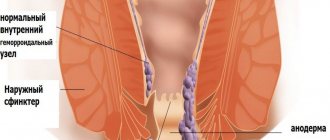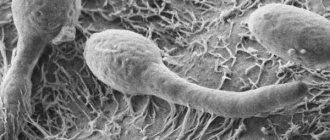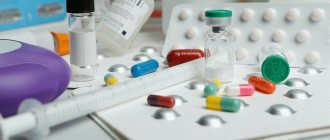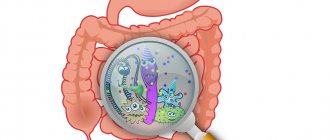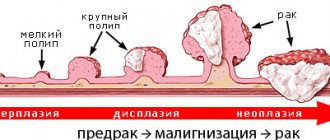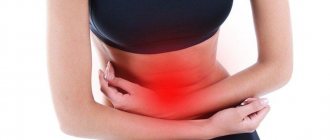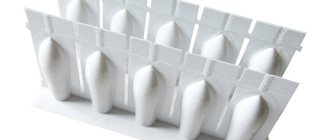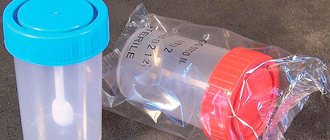Biliary sludge is a clot of bile in the gallbladder. This phenomenon is considered a harbinger of gallstone disease and requires diet and sometimes medication treatment. Sludge appears due to changes in the composition of bile, when it becomes thicker and stagnates in the bladder. The clot usually collects cholesterol, one of the components of bile. It crystallizes and gradually leads to the formation of stones.
Characteristic symptoms of the disease
The occurrence of the disorder is associated with specific clinical signs. The main ones are:
- Soreness in the right side. This localization of sensation is mediated by anatomical features. Biliary sludge syndrome has a lot to do with movement. Clots are capable of changing their location. This process leads to pain.
- Nausea that occurs mainly after eating. Since bile stagnation forms, digestive processes are disrupted. This is accompanied by retention of intestinal contents and gastrointestinal motility slows down. In some cases, patients also complain of vomiting.
- Loss of appetite is also associated with disruption of the digestive system. Anorexia appears in the later stages of pathology development and often requires not only consultation with a gastroenterologist, but also the help of a psychotherapist.
- Changes in stool character are associated with a decrease in enzyme activity. This problem arises because bile normally shifts the acid-base balance in the intestines to the alkaline side. If this does not happen, the proteins involved in food digestion work less well. Patients often complain of constipation.
All information about Azaran on Apteka.ru
Treatment of infectious and inflammatory diseases caused by sensitive microorganisms: - infections of the upper and lower respiratory tract (including pneumonia, lung abscess, pleural empyema); - infections of the skin and soft tissues; - infections of bones and joints; - urinary tract infections (incl.
pyelonephritis); - inflammatory diseases of the gastrointestinal tract and biliary tract (including cholangitis, empyema of the gallbladder); - infections of the pelvic organs; - peritonitis; - bacterial meningitis; - bacterial endocarditis; - sepsis; - acute uncomplicated gonorrhea; — Lyme disease; - shigellosis; — salmonellosis.
- hypersensitivity to the components of the drug; - hypersensitivity to other cephalosporins, penicillins and carbapenems.
The drug is prescribed with caution in cases of impaired liver and/or kidney function, in premature and newborn infants with hyperbilirubinemia, in UC, as well as in enteritis or colitis associated with the use of antibacterial drugs.
Analogs of Azaran in Simferopol
Prices for Azaran in other cities
Buy Azaran, Azaran in St. Petersburg, Azaran in Novosibirsk, Azaran in Yekaterinburg, Azaran in Nizhny Novgorod, Azaran in Kazan, Azaran in Chelyabinsk, Azaran in Omsk, Azaran in Samara, Azaran in Rostov-on-Don, Azaran in Ufa, Azaran in Krasnoyarsk, Azaran in Perm, Azaran in Volgograd, Azaran in Voronezh, Azaran in the Krasnodar region, Azaran in Saratov, Azaran in TyumenOrder delivery in Simferopol
When ordering on Apteka.RU, you can choose delivery to a convenient pharmacy near your home or on your way to work.
All delivery points in Simferopol - 15 pharmacies
| Pharmacy "Harmony"(192) Reviews | Simferopol, st. Kechkemetskaya, 1 | 8(978)054-40-33 | daily from 09:00 to 19:00 | |
| Pharmacy "Harmony"(158) Reviews | Simferopol, st. Vorovskogo, 3 | PAYMENT IN CASH ONLY!!! | 8(978)029-51-61 | daily from 08:00 to 20:00 |
| Pharmacy "Harmony"(65) Reviews | Simferopol, st. Bespalova, 110D | PAYMENT IN CASH ONLY!!! | 8(978)766-48-43 | daily from 08:00 to 20:00 |
| SUDAK, IP *Kostenko V.E.*(28) Reviews | Simferopol, st. Baturina, 85 | VACCINES AND IMMUNOPRECATIONS ARE NOT DISCLAIMED! | 8(978)088-70-01 | daily from 08:00 to 21:00 |
| Pharmacy "GRAND MEDICAL" - PAYMENT IN CASH ONLY(19) Reviews | Simferopol, st. Dzhankoyskaya/ st. Rocket, 85/28 | VACCINES AND IMMUNOPRECATIONS ARE NOT DISCLAIMED! | 8(918)600-52-28 | daily from 08:00 to 20:00 |
| Pharmacy "GRAND MEDICAL" - PAYMENT BY CASH ONLY(1) | Simferopol, st. Ryleeva, 2 | VACCINES AND IMMUNOPRECATIONS ARE NOT DISCLAIMED! | 8(978)802-26-88 | daily from 08:00 to 20:00 |
| Pharmacy IP "Gladkova N.N."(25) Reviews | village Primorsky, st. Sovetskaya, 7 | VACCINES AND IMMUNOPRECATIONS ARE NOT DISCLAIMED! | 8(365)626-34-55 | daily from 08:00 to 20:00 |
| Pharmacy IP "Romanets SV"(20) Reviews | Shchelkino, (not specified), 45 | 8(365)575-30-97 | daily from 08:00 to 20:00 | |
| Pharmacy "Valeo"(20) Reviews | village Primorsky, st. Gagarina, 13 | 8(365)622-86-50 | daily from 08:00 to 20:00 | |
| LENINO, IP *Kuzmenko N.M.*(32) Reviews | urban village Lenino, st. Shosseynaya, 13 | 8(365)576-03-67 | daily from 08:00 to 20:00 |
Causes of sludge syndrome
Doctors identify several factors that contribute to the problem:
- Diets that are too strict, especially those related to limiting fat intake. Since bile is actively involved in the emulsification of lipids, in the absence of these compounds in the diet, stagnation occurs. This provokes an increase in cholesterol concentration and the precipitation of salts.
- Inflammatory processes in the pancreas can also initiate the formation of clots.
- Carrying out operations on the gastrointestinal tract is accompanied by a violation of its motility. Since after such interventions, patients are recommended to have strict dietary restrictions, the risk of congestion in the gallbladder increases.
- Liver damage is a common cause of sludge syndrome. After all, hepatocytes are the main producers of bile. With the formation of cirrhosis or inflammatory changes, pronounced disturbances in the digestive processes occur.
- Cholecystitis, accompanied by a narrowing of the excretory duct, is one of the common etiological factors in the formation of clots. In some cases, the problem is also associated with disruption of the sphincter of Oddi.
- Pregnancy is one of the provoking factors. 20% of expectant mothers are diagnosed with congestion in the gallbladder. They are mainly associated with digestive disorders, the development of toxicosis and changes in metabolism. In such cases, women are advised not to delay visiting a doctor.
Classification
According to the origin of the crystalline suspension, the disease can be primary (essential) and secondary, associated with the action of established etiological factors. When systematizing the variants of biliary sludge, the composition of the crystals (with a predominance of the cholesterol-mucin complex, calcium salts or bilirubin-containing pigments), the presence of cholelithiasis and the contractile activity of the gallbladder are taken into account. To choose therapeutic tactics, it is important to know the ultrasound form of the disease:
- Echo suspension. The initial stage of sludge formation. It is asymptomatic and detected by chance during a routine examination of the patient. Requires dynamic monitoring.
- Biliary sludge clots. The classic variant of the disease with the presence of hyperechoic formations on ultrasound. It is recommended to prescribe active antilithogenic therapy.
- Special forms. Signs of microcholelithiasis, gall bladder cholesterol polyps, and the formation of putty-like bile are revealed. Surgical treatment may be indicated.
Diagnosis of pathology
Before you begin treatment for gallbladder sludge syndrome, it is necessary to conduct a comprehensive examination to confirm the presence of the problem. Identification of the disease begins with the collection of anamnesis, examination and palpation of the patient’s abdominal cavity, during which characteristic soreness is recorded. The most informative method for diagnosing this pathology is ultrasound. It allows you to visualize the contents of the gallbladder, as well as assess the size, approximate composition and mobility of the formed clot. To identify concomitant diseases, general clinical and biochemical blood tests are performed. Stool and urine are also examined.
Diagnostics
Bile conditions can be determined in several ways. For this purpose the following is carried out:
- Assessment of patient complaints, existing symptoms, pain localization.
- Assessment of family history and medical history in order to determine genetic predispositions, existing gastrointestinal and liver diseases.
- Physical examination to determine the degree of pain in the abdomen.
- General examinations of blood, urine and feces in order to identify background and concomitant diseases of sludge and possible complications.
- Blood biochemistry to assess the degree of fermentation disorders in the liver, determine total protein, bilirubin, cholesterol and other blood components.
- Instrumental examination, which includes:
- Ultrasound to identify clots, flakes of gallbladder bile, determine their volume, displacement depending on the position of the patient’s body, and assess the condition of the walls of the organ. Homogeneous bile indicates normality.
- Duodenal intubation for the purpose of microscopic assessment of the quality and quantity of bile from the duodenum.
- CT and MRI to determine the extent of changes in the liver and gallbladder.
Complications and possible consequences
The occurrence of congestion in most cases leads to the development of cholecystitis. Inflammatory processes only aggravate the course of the disease and worsen the further prognosis. A common consequence of sludge syndrome is gallstone disease. Salts accumulate into large conglomerates and clog the biliary ducts. In most cases, such a problem leads to the need for surgery.
The pathology can be asymptomatic. There have also been cases in which the disease resolved on its own and without treatment. However, in 70% of patients, the lack of adequate therapy is accompanied by the formation of common bile duct obstruction. This condition requires emergency care. In the event of a rupture of the gallbladder, peritonitis quickly develops, which even modern medicine often fails to cope with. Perforation is most often diagnosed in elderly patients, which is associated with age-related changes in the hepatobiliary system.
Sludge syndrome can also become more complicated during treatment. When large amounts of cholesterol and salts accumulate, stones form. Many doctors for this pathology recommend complete removal of the gallbladder, especially when this problem occurs against the background of diabetes mellitus or chronic cholecystitis. Only radical surgery can relieve a person of pain, as well as prevent obstruction of the duct and further rupture of the organ.
The accumulation of sediment in the gallbladder is also associated with a high risk of developing pancreatitis. This is due to the anatomical features of the structure of the organ’s excretory ducts. When the bile ducts are blocked, the secretion of pancreatic enzymes is also disrupted, which soon leads to severe inflammation.
General information
Diagnosis of biliary sludge as an independent pathological condition became possible after the widespread introduction of ultrasound methods for examining the liver and biliary tract.
The prevalence of the disorder in the population is 1.7-4%, in patients with diseases of the digestive tract - 7-8%, in patients with hepatobiliary pathology - 24.4-55%. Sludge contains cholesterol crystals, mucin, calcium bilirubinate and other pigments. The disease is most often detected in women over 55 years of age. Most gastroenterologists and hepatologists consider the presence of a crystalline biliary suspension in a patient as a preclinical (pre-stone) form of cholelithiasis.
Biliary sludge
Treatment
The tactics to combat the disease depend both on the severity of the clinical signs and on the results of the diagnostic studies performed. Both traditional drug therapy and folk remedies are used. Diet also plays an important role in getting rid of pathology. However, for effective treatment of sludge syndrome, you need to see a doctor. Otherwise, there is a high risk of complications.
Drugs
Therapy is aimed at removing clots from the gallbladder. Symptomatic treatment is also prescribed. The following drugs are used for this:
- Products based on ursodeoxycholic acid are among the most effective. Examples of such medications are Ursosan and Ursofalk. These drugs are taken in a course and help remove sludge from the gallbladder.
- To improve the effect of the use of ursodeoxycholic acid, antispasmodics such as No-spa and Papaverine are prescribed. They contribute to the expansion of the excretory duct and alleviate the course of the disease.
- When inflammatory processes are detected, the prescription of antibacterial therapy is justified. Broad-spectrum drugs are used, for example, penicillins and cefazolins.
Traditional methods
It is also possible to alleviate the condition of patients at home. Before using prescriptions, it is recommended to consult your doctor:
- St. John's wort has a pronounced anti-inflammatory effect and also promotes the flow of bile. You will need a tablespoon of dried herb, which is poured with a glass of boiling water and simmered on fire for 15–20 minutes. The broth is filtered, cooled and drunk 50 ml three times a day before meals.
- Dill is widely used in the treatment of gastrointestinal pathologies. You will need 2 tablespoons of plant seeds. They are poured with 400 ml of water and boiled for 15 minutes. Cool the finished product and drink half a glass 3-4 times a day before meals.
Prevention
To avoid progression of the pathological condition, it is necessary:
- adhere to the right lifestyle;
- eat healthy foods rich in vitamins and microelements;
- Do not use medications of different spectrum of action beyond the period prescribed by a specialist.
It is necessary to monitor your health and seek medical help in a timely manner to avoid negative consequences and achieve effective treatment. Self-medication in this case is unacceptable; if you feel unwell, you should immediately seek medical help.
Follow a diet
Any doctor, even a therapist, can prescribe a strict diet. Which one? There is such a diet called “table No. 5”. You need to study it carefully and follow the recommendations.
Be patient if you want to heal your gallbladder and remove sludge. The treatment is very long - at least one month. But it's worth it: you can learn how to eat healthy.
What does “table number 5” mean? Firstly, you should eat in small portions (no more than 100-150 grams) at a time. But at the same time you will not remain hungry, because you should eat 5-6 times a day. That is, every 2-3 hours. This way you don't put any strain on your diseased gallbladder.
Secondly, your diet should not contain any flavor enhancer, excluding:
- spices, hot seasonings, mustard, pepper and so on;
- fried, smoked, pickled foods;
- soups with meat and mushroom broths;
- fatty dairy products;
- sour berries, fruits;
- from vegetables: radish, horseradish, onion, garlic;
- ice cream, malmelad toffee, sweets, chocolate;
- bread (today's baked goods), pies, rolls.
What can you eat? Let's list the allowed products:
- tea with milk, fruit drinks and compotes, juices, still water;
- yogurts, sour cream and cottage cheese low-fat or with a fat content of no more than 2-3%;
- lean fish;
- non-acidic vegetables and fruits, preferably pureed;
- boiled sausages and sausages;
- bread made yesterday or earlier;
- mild cheese.
In fact, not everything is as complicated as it seems. You will understand that such a diet will only benefit you: the body will be able to absorb only the necessary substances, and not excess cholesterol and fats.
